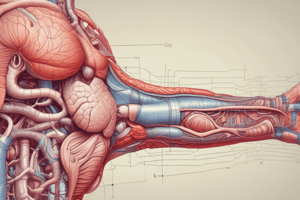Podcast
Questions and Answers
¿Cuál es la función principal del estómago en el sistema digestivo?
¿Cuál es la función principal del estómago en el sistema digestivo?
- Absorber nutrientes
- Descomponer mecánicamente y químicamente los alimentos (correct)
- Producir enzimas digestivas
- Procesar desechos del intestino delgado
¿Cuál es el orden correcto de los órganos en el tracto gastrointestinal?
¿Cuál es el orden correcto de los órganos en el tracto gastrointestinal?
- Stomach, esophagus, small intestine, mouth, anus
- Mouth, esophagus, small intestine, stomach, anus
- Esophagus, mouth, stomach, small intestine, anus
- Mouth, esophagus, stomach, small intestine, large intestine, anus (correct)
¿Qué estructuras en el intestino delgado ayudan a absorber nutrientes?
¿Qué estructuras en el intestino delgado ayudan a absorber nutrientes?
- Prolongaciones nerviosas
- Villi (correct)
- Células epiteliales
- Microvellosidades
¿Cuál es la función del páncreas en el sistema digestivo?
¿Cuál es la función del páncreas en el sistema digestivo?
¿Cuál es el nombre del músculo que conecta el estómago con el intestino delgado?
¿Cuál es el nombre del músculo que conecta el estómago con el intestino delgado?
¿Cuál es el propósito del sistema digestivo?
¿Cuál es el propósito del sistema digestivo?
¿Cuál es la función principal del pácreas en el sistema digestivo?
¿Cuál es la función principal del pácreas en el sistema digestivo?
¿Cuál es el propósito de la bilis en el sistema digestivo?
¿Cuál es el propósito de la bilis en el sistema digestivo?
¿Qué es el microbioma o flora intestinal?
¿Qué es el microbioma o flora intestinal?
¿Cuál es la función principal del hígado en el sistema digestivo?
¿Cuál es la función principal del hígado en el sistema digestivo?
¿Cuál es el proceso por el cual se mueve el contenido intestinal a través del colon?
¿Cuál es el proceso por el cual se mueve el contenido intestinal a través del colon?
¿Qué es el sistema biliar?
¿Qué es el sistema biliar?
Study Notes
The Digestive System: An In-depth Analysis
The digestive system is a complex network of organs and glands that work together to break down food into nutrients for the body to use. This system, which includes the gastrointestinal (GI) tract and the biliary system, plays a crucial role in maintaining health and supporting growth, repair, and energy production. Let's explore the structure and function of the digestive system in detail.
The GI Tract
The GI tract is a series of hollow organs that are all connected to each other, leading from the mouth to the anus. The organs in the GI tract, in order, are the mouth, esophagus, stomach, small intestine, large intestine, and anus. The mouth is the beginning of the digestive tract, where the process of digestion starts before the food is even swallowed. Once food is swallowed, it travels down the esophagus, a muscular tube, and enters the stomach.
The stomach is a muscular bag that churns the food to help break it down mechanically and chemically. The food is then squeezed through a sphincter into the first part of the small intestine, called the duodenum. In the small intestine, the food is mixed with digestive enzymes from the pancreas and bile from the liver. Nutrients are absorbed from the small intestine, which is lined with millions of finger-like projections called villi, and are passed into the bloodstream.
The large intestine, or colon, is responsible for processing waste from the small intestine. The colon is a 6-foot long muscular tube that connects the small intestine to the rectum. Stool is passed through the colon by peristalsis, emptied into the rectum, and eventually eliminated through the anus.
The Biliary System
The biliary system is a network of three organs that deliver bile and enzymes through to the GI tract. The organs that make up the biliary system include the liver, gallbladder, pancreas, and bile ducts. The liver secretes bile, which is stored in the gallbladder and released into the small intestine to help digest fats.
The Pancreas and Liver
The pancreas is a large gland that secretes digestive enzymes into the duodenum to break down protein, fats, and carbohydrates. It also makes insulin, which is released directly into the bloodstream to regulate blood sugar levels. The liver has many functions within the digestive system, including processing nutrients absorbed from the small intestine, detoxifying harmful chemicals, and producing bile to aid in digestion.
The Role of Bacteria
Bacteria in the GI tract, also known as gut flora or microbiome, play an important role in digestion. These bacteria help break down complex carbohydrates and synthesize various vitamins, process waste products and food particles, and protect against harmful bacteria.
Importance of Digestion
Digestion is essential for breaking down food into nutrients, which the body uses for energy, growth, and repair. The body breaks down nutrients from food and drink into carbohydrates, proteins, fats, and vitamins, which are then absorbed into the bloodstream and carried to cells throughout the body.
In summary, the digestive system is a complex network of organs and glands that work together to break down food into nutrients for the body to use. This system, which includes the GI tract and the biliary system, plays a crucial role in maintaining health and supporting growth, repair, and energy production.
Studying That Suits You
Use AI to generate personalized quizzes and flashcards to suit your learning preferences.
Description
Aprende sobre el sistema digestivo, que incluye el tracto gastrointestinal y el sistema biliar, y cómo desempeña un papel crucial en la salud y el crecimiento. Explora la estructura y función de los órganos y glándulas que lo componen.




